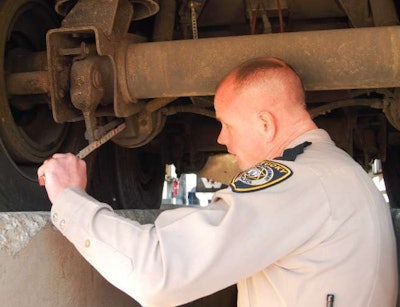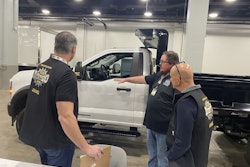
Get ready for Brake Safety Week
- The Commercial Vehicle Safety Alliance (CVSA)'s Brake Safety Week is Aug. 24-30 and inspectors are focusing especially on drums and rotors.
- Regular pre- and post-trip inspections can cut down on breakdowns and violations alike.
- Good communication between technicians and operators can help quickly diagnose and repair brake issues.
Brake Safety Week, Aug. 24-30, is coming up soon and Bendix is offering safety tips ahead of the Commercial Vehicle Safety Alliance (CVSA) inspections.
"During last year's CVSA Brake Safety Week, nearly 13% of the 16,725 vehicles inspected — a total of 2,149 — were placed out of service for brake-related issues," says Brian Screeton, manager of technical training and service at Bendix. "Proper maintenance practices and regular equipment inspection can help prevent many violations. What goes on in the wheel-ends and braking system directly impacts multiple aspects of safe vehicle operation — there's no overstating the importance of keeping up with maintenance and inspection of those areas."
Brake Safety Week is part of CVSA's Operation Airbrake initiative. The campaign aims to reduce the number of highway crashes caused by faulty brake systems on commercial motor vehicles. It involves officials in the United States, Canada and Mexico inspecting trucks and buses.
"How well the brakes and wheel-ends perform when they're needed is tied to proper operation of many other vehicle systems, including stopping power and helping support the performance of higher-level technologies like collision mitigation," Screeton says.
What happens during Brake Safety Week?
CVSA-certified inspectors will conduct inspections throughout the week. These inspections will focus on brake systems and components, checking for:
- Air leaks around brake components and lines.
- Air pressure in the target range of 90-100 psi when checking for air leaks.
- Broken springs in the spring break housing section of the parking brake.
- Holes in tubing caused by rubbing.
- Mismatched air brake chamber sizes across axles.
- Missing, nonfunctioning, loose or cracked parts.
- Proper operation of the tractor protection system.
- Proper brake chamber pushrod travel.
- Drum brake S-cam has cammed over.
- Slack adjusters on the same axle are not at the same length.
- Warning device functionality.
Inspectors will be keeping a special eye on drums and rotors.
Get ready for Brake Safety Week
Screeton says regular pre- and post-trip inspections can make a big difference in catching brake issues before they become problems. Every day, he says:
- Check for damaged or loose-hanging air brake chambers, pushrods or slack adjusters.
- Make sure slack adjusters on each axle are extended out to the same angle.
- Different angles can indicate an out-of-adjustment brake, a broken spring brake power spring, or a broken service brake return spring.
- Examine tubing and hose condition, positioning and connections.
Every week:
- Perform a a 90- to 100-psi brake application with the wheels chocked and the parking brakes released and listen for leaks.
- Check air disc brake (ADB) rotors for cracks.
- Inspect drum brake linings for wear and cracks.
Every month:
- Check for moisture in the air system to prevent contamination that leads to component deterioration and system leaks.
Bendix all recommends any time a vehicle is in the shop is also worth greasing the drum brake S-cam tubes and automatic slack adjusters. Doing so will helps prevent rust and corrosion, purges out water and contaminants from the components and also helps keep the slack functioning properly.
What are the differences between drums and discs?
Air disc brakes and drum brakes have different maintenance needs, including the measurement of brake stroke. Air disc brakes have an internal adjustment mechanism so their brake stroke is not measured externally as with drum brakes. This mechanism lowers the risk of out-of-adjustment violations.

"Measuring a drum brake's chamber stroke is a matter of checking the distance from the face of the air brake chamber to the clevis pin with the brakes released, and then again after a fully charged brake application," Screeton says. "The difference between these measurements is the brake stroke and its maximum length depends upon the brake chamber type and size."

Improperly adjusted brakes can also drag, impacting fuel efficiency and speeding up pad wear or experience decreased stopping power.
Selecting parts for brake system health
The aftermarket is crowded when it comes to brake friction.
"If you notice it's time for new brake friction, then make sure to keep things up to spec: Not all friction that is marketed as acceptable under current reduced stopping distance (RSD) regulations will actually perform to standard," Screeton says.
The wrong choice in brake friction can damage the system and undermine vehicle safety. Improper friction can cause cracks, degradation of brake performance or damage other wheel-end components.
New advancements, such as sealed spring brake chambers and air disc brake pad wear sensing technology, can prevent wheel-end issues typically found during Brake Safety Week.
"Be aware of the friction couple as well — that is, the pairing of brake pads and rotors in air disc brakes," Screeton says. "When those parts are designed in isolation and then paired together, problems can follow — including stress cracks from heat and grooves from uneven wear."
Bendix also says to protect the air supply against corrosive oil aerosols that could lead to leaks and violations. It recommends using an oil-coalescing air dryer cartridge. These can replace standard cartridges but the reverse isn't always the case. Don't downgrade from an oil-coalescing cartridge to a standard. Bendix also says not all oil-coalescing cartridges work the same. It says to replace a cartridge with the same one that was removed from the OEM vehicle.
Supporting technicians
Screeton emphasizes the importance of communication between drivers and technicians.
"A driver out on the road may be the first one to notice an issue with the truck," he says. "It's vital that the driver be able to tell the technician what happened, where it happened and details, such as weather conditions. And it's just as vital for the technician to ask questions to gain a clearer understanding of the situation."
Technicians also must keep up with ever-advancing commercial vehicle safety components and technology. Bendix offers its brake school, a hands-on training program with classes across the country. It also has virtual options. The online brake school has more than 200,000 registered users. Bendix also offers on-site maintenance demos and system troubleshooting education.
At B2Bendix.com, technicians and others can find service manuals, product training documents, installation instructions and more in a document library.











